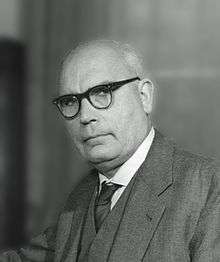Emil Rupp
Emil Rupp (Philipp Heinrich Emil Rupp, 1898–1979) was a German physicist, regarded by many as a respectable and important experimentalist in the late 1920s.[1][2] He was later forced to recant all five of the papers he had published in 1935, admitting that his findings and experiments had been fictions. There is evidence that most if not all of his earlier experimental results were forged as well.
Emil Rupp | |
|---|---|
 | |
| Born | July 1, 1898 |
| Died | April 10, 1979 |
Canal ray experiments
In 1926 Rupp's canal ray experiments seemed to corroborate Einstein's theories on wave–particle duality. He published these results in a paper that was printed next to a theoretical paper on the same subject by Einstein, who evidently accepted Rupp's alleged findings as confirming his (Einstein's) theoretical model. Rupp's experimental results were later shown to have been falsified (although subsequent experimental work re-confirmed Einstein's model).
Exposure of fraud
Although the validity of Rupp's experimental results had been challenged by other workers in the field repeatedly throughout his career, it was not until 1935 that his misdeeds were fully exposed. In 1935 experimentalists Walther Gerlach and Eduard Rüchardt published a corrected version of Einstein's mirror diagram in an article[3] that argued that Rupp had falsely claimed to have carried out the rotated mirror experiment. Some fellow physicists at the AEG labs grew suspicious of Rupp when he claimed having accelerated protons at 500 kV, something he could not have the technical facilities to achieve. Rupp had to publicly retract five publications from the previous year. He attached a psychiatric diagnosis by Dr. Emil von Gebsattel that said he had written them under the influence of "dreamlike states" caused by psychasthenia. Rupp never worked again as a physicist, and all other physicists ceased to refer to any of his alleged results.
References
- "[Emil] Rupp, in the late twenties, early thirties, was regarded as the most important and most competent experimental physicist. He did incredible things." stated Walther Gerlach in an interview with T.S. Kuhn on 18 February 1963, Archive for History of Quantum Physics, cited after van Dongen.
- Jeroen van Dongen: Emil Rupp, Albert Einstein and the Canal Ray Experiments on Wave–Particle Duality: Scientific Fraud and Theoretical Bias. In: Historical Studies in the Physical and Biological Sciences 37 Suppl. (2007), 73–120.
- Rüchardt, Eduard; Walter Gerlach (1935). "Über die Kohärenzlänge des von Kanalstrahlen emittierten Lichtes". Annalen der Physik. 416 (2): 124. Bibcode:1935AnP...416..124G. doi:10.1002/andp.19354160203.
Further reading
- French, A.P.: "The strange case of Emil Rupp", Physics in Perspective, Volume 1, Issue 1, pp. 3–21 (1999) (abstract)
- van Dongen, Jeroen: "Emil Rupp, Albert Einstein and the Canal Ray Experiments on Wave–Particle Duality: Scientific Fraud and Theoretical Bias", Historical Studies in the Physical and Biological Sciences 37 Suppl. (2007), 73–120.
- van Dongen, Jeroen: "The interpretation of the Einstein-Rupp experiments and their influence on the history of quantum mechanics", Historical Studies in the Physical and Biological Sciences, 37 Suppl. (2007), 121–131.
- summary of original documents which also includes a letter (in German) from Arnold Sommerfeld to Rupp, requesting details of an experiment on electron refraction, 30 January 1930